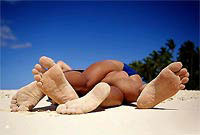Sex tourism opens new horizons for Canadian secretaries
The latest decade was marked by the incredible prosperity of the computer industry as well as by certain novelties in the industry of sex tourism, MIGnews.com reports.

Several countries, which have never before participated in the race for the right to become a country where tourists can use specific services, have stood out at this point during the recent years. In addition to such traditional destinations as Thailand and Southern Mediterranean states the list has been added with the Caribbean countries – Cuba and the Dominican Republic.
The gender affiliation of sex tourism has also suffered some changes. It is generally believed that sex tourism used to be attractive to women in their thirties, lonely and unhappy females. Nowadays, sex tourism enjoys great popularity among men too.
A typical female sex tourist is a middle class woman from a developed country. Citizens of Barbados , an island, which is also included in the group of sex tourism, dubbed such female travelers as “Canadian secretaries.”
Women explore Europe (presumably Holland and the Czech Republic) and the United States, other females brave Africa for new impressions.
The term ‘secretary’ represents the collective image of middle class women. Canadian women make the majority of 600,000 travelers visiting the Caribbean every year for a quick love affair.
The prices of escort services of local males vary from 30 to 150 dollars per hour, depending on women’s means. Successful gigolos can also enjoy gifts, souvenirs, clothing, jewels and accessories.
As for men, they are more traditional in their search for new impressions and bodily pleasures. Bangkok is the most popular destination among men from all over the world.
Female travel sex (involving American and English women) began in Rome in the late 1840s, at the same time as first wave feminism, which encouraged independence and travel.
Affairs and intrigues, particularly between American heiresses and impoverished European aristocrats, continued steadily until World War I, inspiring a whole genre of literature such as Henry James's Daisy Miller, Joaquin Miller's The One Fair Woman, and much of the early output of E.M. Forster.
Female sex travel declined from the time of the Depression until the 1960s.
Coincident with the explosion of leisure travel in the 1960s and second wave feminism, sex tourism by women re-ignited, first via French Canadian women traveling to Barbados and Swedish and Northern European women to Spain, Greece, Yugoslavia and the Gambia. Female sex travel became ubiquitous throughout the Caribbean, from the tiniest islands through the big destinations of Jamaica, the Dominican Republic and Barbados.
In the 1990s, women from Japan and Taiwan began to appear on the beaches of Bali and Phuket in Thailand.
Today, many other destinations are popular, including Morocco, Nepal, Thailand, Ecuador, Costa Rica, Mexico - everywhere with beaches (or in Nepal's case, mountains) and a surplus of underemployed men.
Female sex tourism's first and second waves coincided not only with feminism but with Victorian era man shortages that began in England and later occurred in continental Europe and the United States.
Social reasons for women seeking promiscuous and no-strings-attached sex abroad include the dating war, as typified by extreme competition between the sexes in schools, the workplace, while dating, in marriages, and even in contentious divorces. The dating war appears especially to drive sex tourism by Australian and Japanese women, and to a lesser extent, German and Scandinavian female tourists. The changing theme of pop culture in the wake of the feminist heyday in America and elsewhere cannot be ignored. From the 1970s onward, the emergence of stronger, independent character roles for women in film, music and television doubtlessly influenced the expectations of ordinary women viewers everywhere in the western world.
Subscribe to Pravda.Ru Telegram channel, Facebook, RSS!

